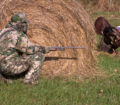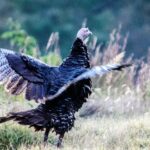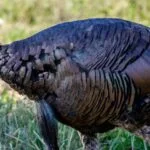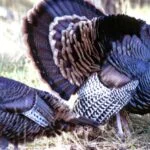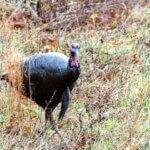Editor’s Note: Wild turkeys have their own vocabulary. Although scientists and hunters attempt to explain the vocabulary of the wild turkey, their statements and conclusions may be contradictory. Not until someone teaches a turkey to speak English will we find out exactly what each sound means.
One of the best ways to learn to talk turkey and to begin to understand the language that hunters use to communicate with wily gobblers is to attend a turkey-calling contest. At a contest, not only will you get to hear master woodsmen give the sounds and calls of the wild turkey, but you’ll also have an opportunity to talk to these hunters and learn when they use which calls and why. Often contestants are willing and eager to share their turkey-calling knowledge with beginners. Sometimes call manufacturers will be in attendance to show their products and help hunters learn how to call.
 Turkey-Hunting Videos, Books and Tapes:
Turkey-Hunting Videos, Books and Tapes:
Another way to learn how to talk like a turkey is through turkey-hunting videos, tapes and CDs. Almost every call manufacturer produces some type of turkey-hunting video, which enables you to hear and see an expert give a call and then imitate the call. By recording the call you make and then listening to the difference between your call and the call made by the hunter on the video, you’ll be able to hear how close you are coming to imitating the call you need to make. You can learn more about calling turkeys by going to johninthewild.com/audio-files/ for audio turkey tapes to purchase of Lovett Williams, Rob Keck and Chris Kirby, available for download to your SmartPhone, tablet or computer.
Turkey-hunting videos for the most part show the hunter how, where, when and why to use a specific call. Many of the videos on the market present the information as though the viewer is on a turkey hunt, allowing him to see a master hunter set-up and call a turkey to within gun range – probably the best way to simulate a successful hunt.
Yet another way to learn how to hunt and call the wild turkey is to read books about turkey hunting. Reading gives you the chance to learn from the best hunters and callers in North America. It gives you access to more information than ever can be crammed into a video.
 To learn more about turkey hunting, check out John E. Phillips’ print, Audible, Kindle and Nook turkey books at https://johninthewild.com/books/#turkey and at www.barnesandnoble.com.
To learn more about turkey hunting, check out John E. Phillips’ print, Audible, Kindle and Nook turkey books at https://johninthewild.com/books/#turkey and at www.barnesandnoble.com.
Calling Situations:
No one can draw-up a blueprint to outfox the wily wild turkey. But in certain calling situations, there are proven techniques that you can employ to increase your chances for success.
* Flat Terrain – A hunter who locates a gobbler in flat, open terrain has three options, including he can:
1) get the turkey excited on the roost by cutting and cackling. Then, when the gobbler flies-down, the bird will run in so fired-up that he never stops to consider why he can’t see the hen.
2) call very little, directing his calls in several directions. The gobbler won’t know the hen’s exact location. Even though the tom may move-in slower, he’ll come-in because he’s yet to pinpoint the source of the calling.
3) direct his calls as far behind him as possible. The tom, assuming that the hen is much farther away, will be less careful when he gets within gun range.
* Dense Brush – Generally turkeys don’t walk through dense cover. Yes, there are some birds in every flock that will break this rule, but that’s so infrequent that your best bet is to avoid thick cover. Here’s why: After the turkey poult climbs out of its egg, its mother teaches it that everything in the woods that it doesn’t recognize will eat it. Hawks and owls will swoop down from above. Coyotes, bobcats, foxes and wild dogs may jump-out from behind bushes. Hunters hide in thick places to shoot turkeys. Therefore, a turkey learns at a very-early age that anything it can’t recognize is dangerous, and that any thick cover probably holds a predator. If you set-up in heavily-wooded cover, you’ll be sitting there for some time before you ever spot a turkey. When hunting areas with a large amount of undergrowth, search for the places where a turkey naturally walks and feeds. Locate a clear spot in the woods, and then sit down, and start your calling.
 * Rain and Snow – One of the best ways to take a gobbler during the spring is to hunt during a rainstorm. The tom won’t be able to hear your approach, and he’s not as likely to see your movement, since the rain is bouncing off the leaves, bushes and trees. More than likely, that tom never before has encountered a hunter during a rainstorm. The result is that he may not be as wary on rainy days as he is on clear, bluebird days.
* Rain and Snow – One of the best ways to take a gobbler during the spring is to hunt during a rainstorm. The tom won’t be able to hear your approach, and he’s not as likely to see your movement, since the rain is bouncing off the leaves, bushes and trees. More than likely, that tom never before has encountered a hunter during a rainstorm. The result is that he may not be as wary on rainy days as he is on clear, bluebird days.
One of the finest gobblers I ever took was bagged in a driving rainstorm. Although the bird was in the middle of a clear pasture with several hens, a friend and I called to the tom. He immediately fired-back a gobble and slowly walked over to the edge of the field. He had an 8-inch beard and 3/4-inch spurs and weighed 19-1/2-pounds.
To learn more about turkey hunting, check out John E. Phillips’ print, Audible, Kindle and Nook turkey books at https://johninthewild.com/books/#turkey and at www.barnesandnoble.com. You also can download a free Kindle app that enables you to read the book on your iPad, computer or SmartPhone. You can learn more about calling turkeys by going to johninthewild.com/audio-files/ for audio turkey tapes to purchase of Lovett Williams, Rob Keck and Chris Kirby, available for download to your SmartPhone, tablet or computer. For a free copy of John E. Phillips’ “The Turkey Gobbler Getter Manual,” go to https://johninthewild.com/free-books/ to download.


